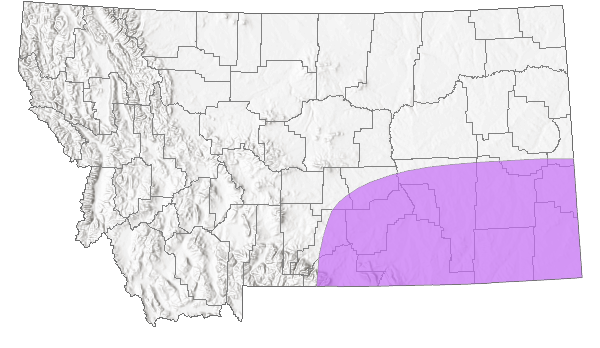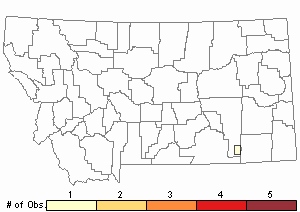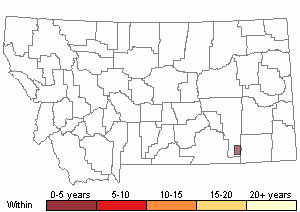View in other NatureServe Network Field Guides
NatureServe
Montana
Utah
Wyoming
Idaho
Wisconsin
British Columbia
South Carolina
Yukon
California
New York
Straight-lanced Meadow Katydid - Conocephalus strictus
General Description
The following comes from Rehn and Hebard (1914), Blatchley (1920), Helfer (1971), Alexander et al. (1972), Vickery and Kevan (1985), Bland (2003), Capinera et al. (2004), Elliott and Hershberger (2007), and Himmelman (2009). This species has the largest body size within the Conocephalus genus and is darker green compared to other meadow katydids. The top of the head is black or dark brown. There is a reddish-brown stripe, edged by white or buff, that traverses the dorsal body surface from the pronotum (thorax) to the abdominal tip. The lateral side of the abdomen, bordering the stripe, is black, merging ventrally into the sides and segments making them very distinct. The tegmina (forewings) are short, in males covering about one-third the length of the abdomen, and in females one-fourth the length.
Calling song description
Verbal descriptions are: (1) “A faint, continuous purr…often with a pulsating quality. Difficult to hear, but in a dense colony the combined sounds of individuals in a chorus can be impressively loud, even overwhelming” (Elliott and Hershberger 2007). (2) “Soft, buzzy, continuous whir” (Himmelman 2009). (3) “Buzz changing speed, alternately slowing and speeding up about every 15-30 seconds…” (Alexander et al. 1972). (4) “The song is a very faint, continuous fluttery buzz, sometimes alternating long periods of a fast, regular pulsation rate with shorter periods of a slower, somewhat irregular, pulsation rate” (Capinera et al. 2004). And (5) “Males perch on vegetation about 1/3 meter above the ground and produce a very soft, continuous buzz that alternately speeds up and slows down 15 seconds” (Bland 2003).
Phenology
This species overwinters in the egg stage. Adults are present from late-July to early-October, depending upon killing frost occurrence (Vickery and Kevan 1985, and Bland 2003).
Diagnostic Characteristics
The following is taken from Rehn and Hebard (1914), Blatchley (1920), Helfer (1971), Alexander et al. (1972), Vickery and Kevan (1985), Bland (2003), Capinera et al. (2004), Elliott and Hershberger (2007), and Himmelman (2009). The male body length is 14-15 mm, and for females 17-18 mm. The pronotum (thorax) for males is 3.5-4 mm, and females 4-4.5 mm. The tegmina (forewing) for males is 5-6 mm, and females 3.5-4.5 mm. The female ovipositor is 18-32 mm. Refer to the illustration to compare the male cerci shape and female ovipositor length.
The Straight-lanced Meadow Katydid could be confused with the
Prairie Meadow Katydid (
Conocephalus saltans), as both species have wings shorter than their abdomens. Refer to the illustration to compare the male cerci shape and female ovipositor length (Scott journal note, 2021).
Species Range
Montana Range
Range Descriptions

 Native
Native
Range Comments
This species occurs from the east coast of Massachusetts, westward to the southernmost portion of Ontario, to the southeastern corner of Montana, then southward east of the Rocky Mountain Front into Arizona, New Mexico, and eastward across the Gulf Coast states to Georgia (absent in Florida). They may occur in large numbers, but their distribution tends to be patchy within the geographical range. In Montana, this species has been reported in three counties (Vickery and Kevan 1985, Bland 2003, and Walker SINA website 2020).
Observations in Montana Natural Heritage Program Database
Number of Observations: 1
(Click on the following maps and charts to see full sized version)
Map Help and Descriptions
Relative Density

Recency



 (Observations spanning multiple months or years are excluded from time charts)
(Observations spanning multiple months or years are excluded from time charts)
Habitat
Inhabits mixed grass and forb areas of dry upland fields, pastures, roadsides, and open pine stands (Vickery and Kevan 1985, and Bland 2003).
Food Habits
No specific information relative to food habits for this species can be found. However, in view of its habitat, it is probably that of the other Conocephalus species.
Reproductive Characteristics
To date, no detailed studies nor observations specific to this species have been found within the published literature.
Stewardship Responsibility
References
- Literature Cited AboveLegend:
 View Online Publication
View Online Publication Alexander, R.D., A.E. Pace, and D. Otte. 1972. The singing insects of Michigan. The Great Lakes Entomologist 5(2):33-69.
Alexander, R.D., A.E. Pace, and D. Otte. 1972. The singing insects of Michigan. The Great Lakes Entomologist 5(2):33-69. Bland, R.G. 2003. The Orthoptera of Michigan—Biology, Keys, and Descriptions of Grasshoppers, Katydids, and Crickets. East Lansing, MI: Michigan State University Extension, Bulletin E-2815. 221 p.
Bland, R.G. 2003. The Orthoptera of Michigan—Biology, Keys, and Descriptions of Grasshoppers, Katydids, and Crickets. East Lansing, MI: Michigan State University Extension, Bulletin E-2815. 221 p. Blatchley, W. 1920. Orthoptera of Northeastern America, section Phaneropterinae pp. 459-494. In: Nature Publishing, Indianapolis, IN.
Blatchley, W. 1920. Orthoptera of Northeastern America, section Phaneropterinae pp. 459-494. In: Nature Publishing, Indianapolis, IN. Capinera, J.L., R.D. Scott, and T.J. Walker. 2004. Field Guide to Grasshoppers, Katydids, and Crickets of the United States. Ithaca, NY. Cornell University Press.
Capinera, J.L., R.D. Scott, and T.J. Walker. 2004. Field Guide to Grasshoppers, Katydids, and Crickets of the United States. Ithaca, NY. Cornell University Press. Elliott, L. and W. Hershberger. 2007. The songs of insects. New York, NY: Houghton Mifflin Harcourt. 227 p.
Elliott, L. and W. Hershberger. 2007. The songs of insects. New York, NY: Houghton Mifflin Harcourt. 227 p. Helfer, J.R. 1971. How to Know the Grasshoppers, Crickets, Cockroaches, and Their Allies. Revised edition (out of print), Mineola, NY: Dover Publications.
Helfer, J.R. 1971. How to Know the Grasshoppers, Crickets, Cockroaches, and Their Allies. Revised edition (out of print), Mineola, NY: Dover Publications. Himmelman, J. 2009. Guide to Night-Singing Insects of the Northeast. Mechanicsburg, PA: Stackpole Books. 160 p.
Himmelman, J. 2009. Guide to Night-Singing Insects of the Northeast. Mechanicsburg, PA: Stackpole Books. 160 p. Rehn, J.A. and M. Hebard. 1914. Studies in American Tettigoniidae. Transactions of the American Entomological Society x1:271-344.
Rehn, J.A. and M. Hebard. 1914. Studies in American Tettigoniidae. Transactions of the American Entomological Society x1:271-344. Scott, R. 2021. Personal journal note.
Scott, R. 2021. Personal journal note. Vickery, V. R. and D. K. M. Kevan. 1985. The grasshopper, crickets, and related insects of Canada and adjacent regions. Biosystematics Research Institute, Ottawa, Ontario. Publication Number 1777. 918 pp.
Vickery, V. R. and D. K. M. Kevan. 1985. The grasshopper, crickets, and related insects of Canada and adjacent regions. Biosystematics Research Institute, Ottawa, Ontario. Publication Number 1777. 918 pp. Walker T.J.(ed.). 2020. Singing insects of North America. Accessed 10 February 2021. https://orthsoc.org/sina/
Walker T.J.(ed.). 2020. Singing insects of North America. Accessed 10 February 2021. https://orthsoc.org/sina/
- Additional ReferencesLegend:
 View Online Publication
View Online Publication
Do you know of a citation we're missing? Fulton, B.B. 1933. Stridulating organs of female Tettigoniidae (Orthoptera). Entomological News XLIV:270-275.
Fulton, B.B. 1933. Stridulating organs of female Tettigoniidae (Orthoptera). Entomological News XLIV:270-275. Gwynne, D.T. 2001. Katydids and Bush-Crickets, Reproductive Behavior and Evolution of the Tettigoniidae. Ithaca, NY: Cornell University Press.
Gwynne, D.T. 2001. Katydids and Bush-Crickets, Reproductive Behavior and Evolution of the Tettigoniidae. Ithaca, NY: Cornell University Press. Scott, R.D. 2010. Montana Grasshoppers, Katydids, and Crickets A Pictorial Field Guide to the Orthoptera. MagpieMTGraphics, Billings, MT.
Scott, R.D. 2010. Montana Grasshoppers, Katydids, and Crickets A Pictorial Field Guide to the Orthoptera. MagpieMTGraphics, Billings, MT.
- Web Search Engines for Articles on "Straight-lanced Meadow Katydid"
- Additional Sources of Information Related to "Insects"





